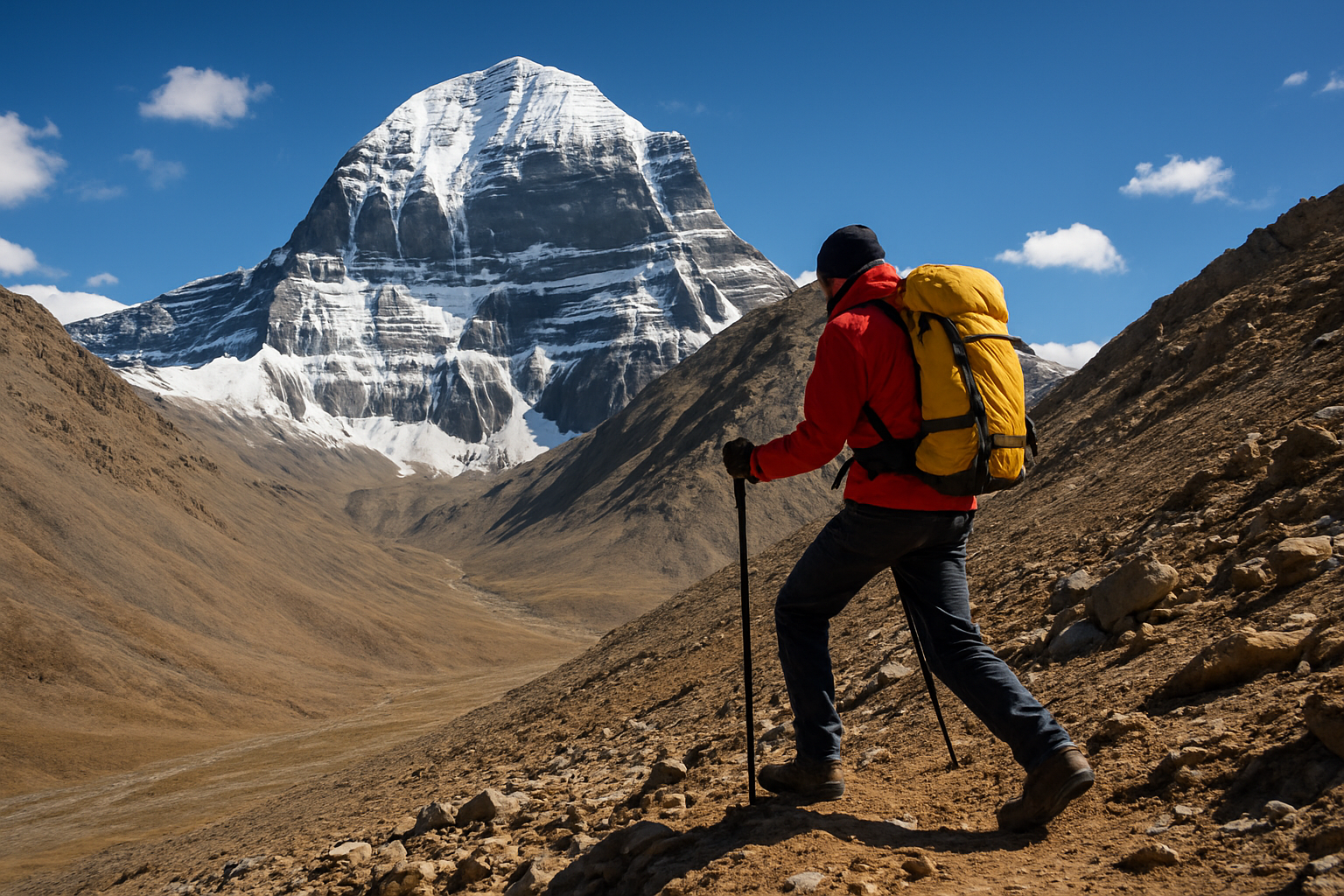Nestled in the far reaches of western Tibet, the mountain known as Mount Kailash rises in quiet majesty. Though not the highest peak in the Himalayas, its location, form and spiritual weight give it a distinct place in human history and belief. Many pilgrims and travellers are drawn to its slopes—not to conquer it, but to touch a timeless sense of wonder.
Yet when it comes to climbing Kailash, the topic becomes rare and controversial. Unlike the many peaks that challenge mountaineers, this mountain is largely off-limits to traditional ascent. This sets the stage for a journey that blends adventure, faith and respect for one of the world’s most sacred peaks. In this article, we’ll explore what makes climbing Kailash such a unique subject: its sacredness, the landscape, the attempts and restrictions, the more common pilgrimage route, how to prepare for a visit—and, above all, what it means to approach this mountain with humility and awe.
Understanding the Sacredness of Mount Kailash
Mount Kailash holds a special place across several faiths. For followers of Hinduism it is the mythical abode of Shiva, the great god of transformation and meditation. In the traditions of Buddhism, it is seen as a sacred axis of the universe, a living mandala and centre of spiritual energy. For Jainism, the peak is the place where the first Tirthankara attained liberation, and for the native Bon religion of Tibet, the mountain is a place of primal power and cosmic significance.
Because of this shared reverence, many believe that climbing Kailash in the usual sense would disrespect the sacredness of the site. Over time, the idea that the summit should remain untouched has become part of the mountain’s story.
In other words, the difficulty of climbing isn’t simply about rock, ice or altitude: it’s about ethics, culture and spirituality. For many, the moral and spiritual reasons behind the climbing restrictions are just as important as the physical ones. The mountain remains, in the eyes of many, a realm of the divine rather than a playground for human ambition.
The Geography and Mystique of Mount Kailash
Located in the remote Ngari Prefecture of the Tibet Autonomous Region of China, Mount Kailash rises to about 6,638 metres (21,778 ft) above sea level. It stands in the Gangdise (Kailash) Range, part of the wider Transhimalaya system. The mountain’s surroundings are remarkable: the landscape includes high-altitude lakes such as Lake Manasarovar, whose glacial waters lie not far from the peak, and the sources of some of Asia’s great rivers.
Visually, the mountain is striking. Its near-symmetrical pyramid-like form, its snow-covered ridges and isolated location all add to its mystique. As one guide described it, it “is neither a mountain for mountain climbers, nor for thrill-seekers. But it is a pilgrimage fort and a spiritual seeker mountain.”
That sense of isolation and untouched quality contributes to the fascination. Unlike many peaks where expeditions bustle and routes are well-worn, climbing Kailash remains a different category of journey: one where the landscape itself is embedded in religious meaning, and the remote geography reinforces its otherness.
The History of Climbing Attempts and Restrictions
When it comes to climbing Kailash, the historical record is thin. Early explorers surveyed the mountain, but no verifiable expedition is recorded to have reached the summit. The reasons are multiple. Some were practical: extreme remoteness, unpredictable weather, high altitude, and logistical complexity. But more importantly, the sacred nature of the mountain has been a major barrier.
In more recent decades, these cultural and religious concerns have translated into official restrictions. The Chinese authorities, recognizing the mountain’s spiritual significance and the sensitivity of the site, have imposed bans or strong prohibitions on full-scale mountaineering. Thus the legend of the “unclimbed mountain” grows.
For those who dream of high-altitude conquests, climbing the tallest peaks in the world may be their goal. But when it comes to Mount Kailash, the more common view among local communities and religious tradition is that its summit is sacred and should not be touched by human boots. Over time, that idea itself becomes part of the mountain’s story—a story where restraint and reverence replace conquest.
The Alternative Pilgrimage — The Kailash Kora
Because reaching the summit is not the goal, one of the most meaningful experiences around Mount Kailash is the traditional trek known as the “kora” or pilgrimage circuit. This involves a circumambulation of the mountain’s base, walking the full loop in an act of devotion.
Typically, the route starts at a small town at the foot of the mountain (such as Darchen), and over three days (or more) pilgrims walk the 50-60 kilometre circuit, often passing a high pass at over 5,600 metres, where views open to the north face of Kailash.
Along this trek, pilgrims may prostrate, meditate or reflect. They are walking rather than climbing—choosing a path of humility and reverence. For many the physical exertion is real, but the richer significance lies in the journey’s slow pace, the high altitude, the stark environment, and the quiet sense of participating in something ancient and sacred.
Walking the kora rather than climbing the summit becomes a spiritual metaphor in itself: one step after another, the pilgrim circles the mountain, acknowledges its presence and significance, and is transformed by the experience.
Preparing for a Journey to Mount Kailash
If you’re considering a journey to Mount Kailash—and especially if the idea of climbing Kailash has crossed your mind—it’s important to prepare carefully. While actual summit-attempts are generally prohibited, the pilgrimage route is demanding and requires planning.
First, timing matters. The best time to visit is usually during the warmer months (June to September) when mountain passes are more open and weather less severe. Because the region is remote and the altitude high, travel routes may be long and slow. One common route is from Lhasa (Tibet) or from Nepal across the border.
Next, permits and paperwork are crucial. Because Mount Kailash lies in a sensitive border and plateau region, foreign travellers often need special travel permits beyond a standard visa. It is wise to go with a registered tour or guide who understands the rules.
Physical readiness also matters. The altitude is high—many parts of the journey lie above 4,000–5,000 metres. You’ll want to spend time acclimatising, be in reasonable health, and bring appropriate gear: warm clothing, layered insulation, good boots, and basic high-altitude travel essentials.
Travel responsibly and respectfully. Since the mountain holds religious significance for Hindus, Buddhists, Jains and Bon followers, your attitude matters. Respect local customs, avoid loud behaviour, leave no trace, and show humility. This isn’t about hiking a trail, it’s about walking in a sacred landscape.
The Deeper Meaning Behind Not Climbing Kailash
Perhaps the most compelling part of the story of climbing Kailash isn’t the ascent at all—it’s the fact that for many, the mountain’s summit remains untouched. In a world of peaks to conquer, the idea that one may choose not to climb is itself profound.
There is a lesson of humility and reverence: recognising that the mountain has meaning beyond human ambition. For many faith traditions the very act of not climbing the summit is an act of respect. The untouched peak becomes a symbol of human limits and divine presence.
In this way, Mount Kailash offers a metaphor: some journeys are about inner ascent more than outer conquest. The mountain invites the traveller to pause, to circle, to reflect. Many people who complete the kora return with a changed outlook—less concerned with reaching the top, more appreciative of the journey itself.
The summit of Kailash may remain out of reach—and that’s part of its power. The mountain stands as a reminder that not all summits are meant to be climbed, and sometimes the greatest elevation is within.
Conclusion
In the story of climbing Kailash, adventure meets spirituality. Mount Kailash is not simply a mountain to be scaled—it is a sacred presence to be honored. The harmony between exploration and faith, between physical terrain and human inner life, gives this journey its quiet power.
True climbers of Kailash may be those who climb inward rather than up; who treat the mountain with respect rather than challenge it; who walk the kora with reverence rather than fix their eyes solely on the peak.
If you are drawn to Mount Kailash, approach it with humility, wonder and sensitivity. In doing so you join a long line of pilgrims, seekers and travellers who have found meaning not just in a summit, but in the journey itself.
My name is Micheal Lovell. I am a dedicated travel writer with over 7 years of experience in creating informative and engaging travel content. Throughout my journey, I have published travel blogs that help readers explore new destinations, plan better trips, and discover local cultures and hidden gems around the world. My goal is to provide practical travel insights through well-researched articles that inspire and guide travelers at every step of their journey.










